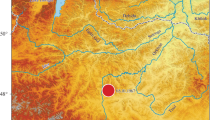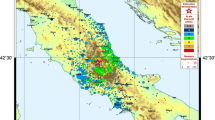Abstract
On 22 April 2013 an earthquake of magnitude 4.8 occurred near the village of Tenk (Hungary), which was the strongest Hungarian earthquake in the past 28 years. This event was detected by a number of seismological stations, thus it is well documented. Nevertheless, it is still possible to get further data through macroseismic surveys, which cannot be obtained using seismological instruments, but are very useful for the understanding of seismic properties of the affected area. The studied earthquake was felt in approximately third of the territory of Hungary. The number of incoming macroseismic questionnaires was over eight hundred and damage descriptions for the epicentral area reached almost one thousand. Intensity evaluation was carried out following the European Macroseismic Scale guidelines. Intensities were assigned to 211 places, including 23 districts of Budapest. The earthquake caused non-structural building damages, the epicentral intensity was estimated as VI on the EMS-98 scale and was assigned to three villages: Tenk, Átány and Erdőtelek. The event was widely felt west to the epicentre, but much less observed in the east direction. The asymmetry of the intensity distribution raises questions and requires further investigation.






Similar content being viewed by others
References
Association of Hungarian Insurance Companies (2013) http://www.mabisz.hu/images/stories/docs/sajto/mabiszsajtotajekoztato20130509.pdf
Bada G, Horváth F, Cloetingh SAPL, Coblentz DD, Tóth T (2001) Role of topography-induced gravitational stresses in basin inversion: the case study of the Pannonian basin. Tectonics 20:343–363
Bada G, Dövényi P, Horváth F, Szafián P, Windhoffer G (2007) Jelenkori feszültségtér a Pannon-medencében és alpi-dinári-kárpáti környezetében. Földtani Közlöny 137(3):327–359
Bada G, Horváth F, Dövényi P, Szafián P, Windhoffer G, Cloetingh SAPL (2007b) Present-day stress field and tectonic inversion in the Pannonian basin. Glob Planet Change 58(1):165–180
Bus Z, Grenerczy Gy, Tóth L, Mónus P (2009) Active crustal deformation in two seismogenic zones of the Pannonian region–GPS versus seismological observations. Tectonophysics 474(1):343–352
Cecić I, Musson R (2004) Macroseismic surveys in theory and practice. Nat Hazards 31(1):39–61
Csontos L, Nagymarosy A (1998) The Mid-Hungarian line: a zone of repeated tectonic inversions. Tectonophysics 297(1):51–71
Csontos L, Nagymarosy A, Horváth F, Kovac M (1992) Tertiary evolution of the Intra-Carpathian area: a model. Tectonophysics 208(1):221–241
Fodor L, Bada G, Csillag G, Horváth E, Ruszkiczay-Rüdiger Zs, Palotás K, Síkhegyi F, Timár G, Cloetingh SAPL, Horváth F (2005) An outline of neotectonic structures and morphotectonics of the western and central Pannonian Basin. Tectonophysics 410(1):15–41
Gerner P, Bada G, Dövényi P, Müller B, Onescu MC, Cloetingh SAPL, Horváth F (1999) Recent tectonic stress and crustal deformation in and around the Pannonian basin: data and models. In: Durand B, Jolivet L, Horváth F, Séranne M (eds) The Mediterranean basins: tertiary extension within the Alpine orogen, vol 156. Geological Society, London, Special Publications, pp 269–294
Gosar A (2014) Analysis of the impact of fault mechanism radiation patterns on macroseismic fields in the epicentral area of 1998 and 2004 Krn mountains earthquakes (NW Slovenia). The Scientific World Journal, Hindawi Publishing Corporation
Gráczer Z, Czanik Cs, Czifra T, Győri E, Kiszely M, Mónus P, Süle B, Szanyi Gy, Tóth L, Varga P, Wesztergom V, Wéber Z (2014) Hungarian National Seismological Bulletin 2013. Kövesligethy Radó Seismological Observatory, Budapest, (in preparation)
Grad M, Tiira T (2009) The Moho depth map of the European Plate. Geophys J Int 176(1):279–292
Grünthal G, Musson R, Schwarz J, Stucchi M (1998) European Macroseismic Scale 1998 (EMS-98), Centre Européen de Géodynamique et de Séismologie, Luxembourg, p 99
Horváth F (1993) Towards a mechanical model for the formation of the Pannonian basin. Tectonophysics 226(1):333–357
Horváth F (1995) Phases of compression during the evolution of the Pannonian Basin and its bearing on hydrocarbon exploration. Mar Pet Geol 12(8):837–844
Horváth F (2007) A Pannon-medence geodinamikája—Eszmetörténeti tanulmány és geofizikai szintézis. ELTE Földrajz- és Földtudományi Intézet, Geofizikai Tanszék, Budapest, p 238
Horváth F, Cloetingh SAPL (1996) Stress-induced late-stage subsidence anomalies in the Pannonian basin. Tectonophysics 266(1):287–300
Horváth F, Bada G, Windhoffer G, Csontos L, Dombrádi E, Dövényi P, Fodor L, Grenerczy Gy, Síkhegyi F, Szafián P, Székely B, Timár G, Tóth L, Tóth T (2006) Atlas of the present-day geodynamics of the Pannonian basin: Euroconform maps with explanatory text. Magy Geofiz 47:133–137
Kitaibel P, Tomtsányi Á (1814) Dissertatio de terrae motu in genere, ac in specie Mórensi anno 1810. die 14. Januarii orto. Typis Regiae Universitatis Hungaricae, Budae, Reprint: Akadémiai Kiadó, Budapest, Hungary, 1960
KSH (2013) Gazetteer of Hungary 1st January, 2013. Központi Statisztikai Hivatal, Budapest
Lenkey L (1999) Geothermics of the Pannonian basin and its bearing on the tectonics of basin evolution. PhD thesis, Vrije Universiteit, Amsterdam, The Netherlands
Lenkey L, Dövényi P, Horváth F, Cloetingh SAPL (2002) Geothermics of the Pannonian basin and its bearing on the neotectonics. In: Cloetingh SAPL, Horváth F, Bada G, Lankreijer AC (eds) Neotectonics and surface processes: the Pannonian basin and Alpine/Carpathian system, vol 3. EGU Stephan Mueller Special Publication Series, pp 29–40
Ratschbacher L, Merle O, Davy P, Cobbold P (1991) Lateral extrusion in the Eastern Alps, part 1: boundary conditions and experiments scaled for gravity. Tectonics 10(2):245–256
Réthly A (1910) Az 1810 januárius 14-iki móri földrengés. Földtani Közlöny 40(3–4):133–155
Royden L (1988) Late Cenozoic tectonics of the Pannonian basin system. In: Royden L, Horváth F (eds) The Pannonian Basin: a study in Basin evolution, vol 45. Memoir, American Association of Petroleum Geologists, pp 27–48
Royden LH, Horváth F, Burchfiel B (1982) Transform faulting, extension, and subduction in the Carpathian Pannonian region. Geol Soc Am Bull 93(8):717–725
Tóth L, Mónus P, Zsíros T (1989) The Berhida (Hungary) earthquake of 1985. Gerlands Beitr Geophys 98(4):312–321
Tóth L, Mónus P, Zsíros T, Kiszely M (2002) Seismicity in the Pannonian Region—earthquake data. In: Cloetingh SAPL, Horváth F, Bada G, Lankreijer AC (eds) Neotectonics and surface processes: the Pannonian basin and Alpine/Carpathian system, vol 3. EGU Stephan Mueller Special Publication Series, pp 9–28
Wessel P, Smith W (1998) New, improved version of generic mapping tools released. Eos Trans 79:579–579
Wessel P, Smith WH (1991) Free software helps map and display data. EOS Trans 72:441–446
Zsíros T (1996) Macroseismic focal depth and intensity attenuation in the Carpathian region. Acta Geod Geophys Hung 31(1–2):115–125
Zsíros T (2000) A Kárpát-medence szeizmicitása és földrengés veszélyessége: Magyar földrengés katalógus (456–1995). MTA GGKI
Zsíros T (2004) Seismicity of Komárom-Mór area. Acta Geod Geophys Hung 39(1):121–132
Zsíros T, Mónus P, Tóth L (1990) Computer estimation of intensities: the 1985 Berhida, Hungary, earthquake. Pure Appl Geophys 132(3):533–543
Acknowledgments
The authors are indebted to the National Directorate General for Disaster Management, especially Lt. Col. Zsolt Szarka for their kind help in damage data acquisition. We would like to thank Tamás Szopkó, mayor of Tenk, for his help. We are very grateful to the European-Mediterranean Seismological Centre for the provided macroseismic questionnaires. This study was supported by the TAMOP-4.2.2.C–11/1/KONV-2012-0015 (Earth-system) project sponsored by the EU and European Social Foundation and the Hungarian Scientific Research Fund under Grant OTKA K105399. Maps were generated with the Generic Mapping Tools (GMT) data processing and display software package (Wessel and Smith 1991, 1998).
Author information
Authors and Affiliations
Corresponding author
Rights and permissions
About this article
Cite this article
Szanyi, G., Gráczer, Z. & Győri, E. Macroseismic intensity data of the 22 April 2013 Tenk (Hungary) earthquake. Acta Geod Geophys 49, 283–294 (2014). https://doi.org/10.1007/s40328-014-0060-x
Received:
Accepted:
Published:
Issue Date:
DOI: https://doi.org/10.1007/s40328-014-0060-x




